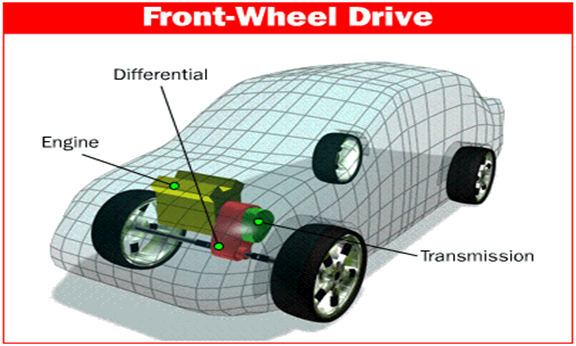Image source: mechanicalmania.blogspot.com
When buying a new car it is difficult to decide which drivetrain style to choose. This article will highlight the pros and cons of using front-wheel drive (FWD) to help you make quality decisions. The front-wheel-drive transmission increases the safety of the vehicle and reduces wheel spinning.
Pros:
1. Fuel economy: Front Wheel Drive is lighter and more fuel economical since it has less heavy transmission according to the report by Mantrans LLC transmission technicians. The lighter it is the better the fuel economy ratings.
2. Easy to drive: Compared to other types of transmission, FWD vehicles are easy to drive especially for new drivers.
3. Inexpensive: Cars that have FWD are cheap compared to rear-wheel transmission vehicles. They are cost-effective in designing and building.
4. Easy to install: FWD vehicles are easy to install and assemble the car. There are no separate transmission and assembly needed on the car.
5. Better traction: They provide better traction compared to rear-wheel vehicles. The front wheels pull the car forward. The car engine fitted at the top of the front drive gives it more grip on the ground. The vehicles can function well in poor weather conditions although not as much traction as in AWD.
6. Save space: The drivetrain is packed into a compartment at the front of the car and there is no need of a drive shaft. Packaging the drivetrain at the front gives you more space for passengers and cargo.
7. More Mileage: The lightweight of a front-wheel-drive have an impact on the vehicle mileage. The vehicles have better gas mileage compared to RWD or AWD vehicles. Its mileage makes the vehicle more affordable.
8. More efficient: Almost all modern vehicles are fitted with FWD due to their efficiency and less powertrain loss.
9. Protection: The transmission and engine at the FWD vehicle provide protection in case of a front-end collision.
10. Left-foot breaking: Use can use the left-foot braking technique in front-wheel drive vehicles.
Cons:
1. Heavy front: FWD heavy front makes them unsuitable for performance vehicles and less optimal handling.
2. Not suitable for a sports car: The front-wheel-drive function by putting power on the ground and steering the car thus making them not optimal for the performance of high-speed vehicles like sports cars.
3. High maintenance cost: Although the cars are very cheap to manufacture, they have a high maintenance cost.
4. Poor handling: FWD transmission leads to poor handling of the car because the whole power is spread at its front wheel. This results in less friction of tires on the ground.
5. Fragile: Compared to rugged lump casts of the rear-wheel drive, the half-shafts and constant velocity joints in the front-wheel-drive are more to susceptible injury.
6. Torque steer: It is difficult for high-power-driven vehicles to handle the torque steer since wheels can jerk left or right while the car is accelerating.
7. Difficult to replace clutches: Vehicle clutches are very difficult to replace due to how their engine is packaged.
8. Wear of front tires: 90% of the breaks are applied at the fronts causing a lot of tire wearing at the front. Steering and acceleration also contribute to the wearing of front tires.
9. Weight balance: FWD vehicles are more front-biased since the engine and drivetrain are packaged at the front axle of the vehicle. All the weight is concentrated on the front tires.
10. Turning circle: The driveshaft may increase the front-wheel drive turning circle compared to RWD.



